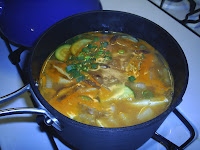
July 2007. This is when boredom really began to set in and the urge to cook became ever stronger. The week of Fourth of July, my parents went on vacation and left me in charge of the house. I dutifully used the car for only two purposes: going to work and grocery shopping. The adventure began July 3 when I ran out of other things to do. I don't remember the exact order I made these foods in but ... what does that matter.
This first picture is of what I call a zucchini scramble. This may have been prior to any grocery purchasing expedition. I like zucchini, I like eggs, and I like cheese. Oh, I was also in a basil phase in which every egg-related food automatically required a healthy dose of the herb. Not quite knowing what I was doing or where I was going with the dish, I sauteed the zuchs first, then poured in the scrambled egg. Honestly, I can't really say what I was thinking at the time. Then again, since I made this shortly after waking up, it's hard to say that I was thinking much at all. Taste-wise it was digestible but it probably would've been better off as an omelette with the zuchis quartered. Halved was a bit on the large side for me.

This is another fried rice. My original intention was to do a poor man's bibimbap but there are simply far too many ingredients involved. So what's in the fridge? More zucchini. Oh, and broccoli, match stick carrots, and our good friend the egg. Not too much to say about this except that the fried egg doesn't really look like a heart, does it? Oh well.

During my exchange student days at Yonsei University, a fellow student introduced me to the brand new world of "toast," a whole new way of looking at a crusty piece of bread. "Toast" (or toastu, as it will be referred to as such henceforth) is actually not toasted. The bread is warmed over a buttered skillet. Meanwhile, vegetables are loaded into scrambled egg and flattened out into a patty. Corn is usually involved. Cabbage, carrots, and other unidentifiable veggies may also appear on the scene depending on who's making it. Slightly fancier toastu establishments offer different toppings such as processed cheese, bulgogi, ham, and other things.
Well, I wasn't personally keen on making a big deal out of this so I went with the basic corn/cheese/ham combo. Aside from (again) overloading the egg with corn, it tasted pretty darn good. This is one food that could definitely be exported to the US with great success.

This is supposed to be bibim nangmyun, or mixed cold noodles. In mool nangmyun (cold water noodles) the noodles are bathed in a shallow beef broth in addition to a spicy sauce. Vinegar and mustard (or something mustard-esque I think) are served on the side as condiments. Well, I didn't have time or the forethought to get a hold of beef broth so... this one is sans the mool.
Let's go clockwise, starting with the carrots. Carrots. Cucumber. Half a boiled egg. Ultra spicy red pepper sauce. Now... I didn't intend for the sauce to be that spicy but like I've told you before, I'm bad with proportions. It's a mixture of red pepper paste (gochujang), sugar, chopped garlic, red pepper powder, and probably some other things I'm forgetting. Anyway, if you're dealing with a red pepper paste, it's probably not necessary to put in that much powder. More does NOT equal tastier.
I had mixed feelings about the result. It may have tasted ok but secretly I'm not a big fan of nangmyun. "Then why the hell did you make?" you ask. Good question. Because it seemed easy and I just felt like making something.
Hi, my name is dwen jang kook (soy bean past soup). This was another one of my favorites in Korea. However, no matter how many times I've made it, no matter how many variations I put on it, it has never tasted great. The secret is... coming later.
This is another one of those dishes that looks really easy on the outside but is waiting to frustrate you with glee on the inside. The key thing is watching the proportions (uh oh) of soy bean paste, water, and maybe gochujang if you want it. Again, I always make this way too spicy.
As for the main ingredients, I usually put in my pal zucchini, tofu, white onion, green onion, and potato. I've also added spinach. For as mediocre as it turned out, it was admittedly really easy to make. That could be the reason I've made this so many times in an undelicious way even though I knew the ... SECRET INGREDIENT(s). Here it is.
.
.
.
.
.
Seafood. In order to make a tasty broth, you have to add @%%^$^#* seafood. Maybe you can figure out that I don't much care for seafood. At any rate, standard additions are dried kelp, dried sardines, and/or some other nasty creatures of the sea. There was and is no way that I would shell out the money for those just to make the soup base. While I mostly hate seafood, I'll grant that it can make an ordinary soup broth taste much better. Oh, and if you do add those, don't forget to scoop out the little sardines' entrails!!!
P.S. You don't eat the above ingredients. You remove them before adding the vegetables or before serving. Or I suppose you could leave it all in and have the guest discover that a disdainful eye is looking at them from the soup.
 The long awaited continuation of my July 3-4th cooking extravaganza... Once again, these are completely out of order, not that you or I care.
The long awaited continuation of my July 3-4th cooking extravaganza... Once again, these are completely out of order, not that you or I care.










